
Discovering Vatnajökull National Park, the largest national park in Europe
One of the most striking and attractive features of Iceland is its natural environment. It’s pretty unique, varied, and has some elements that can’t be found anywhere else. All the landscapes that can be found on this Nordic island are the result of the interaction of several natural forces, such as glaciers and volcanoes. For this reason, the country is often called the Land of Ice and Fire. And for the ice, there’s nothing like the Vatnajökull National Park.
This protected area, which covers nearly 14% of Iceland, and is a UNESCO World Heritage Site, is a tapestry of raw beauty. It’s home to one of the largest glaciers in the world and has some of the most astonishing sights in Iceland.
Come with us to discover this world of wonders.
Key Takeaways
- Vatnajökull National Park is the largest national park in Iceland and Europe.
- It gets its name from the Vatnajökull glacier, the biggest ice cap in the continent outside the Arctic Circle.
- It’s a UNESCO World Heritage Site.
About Vatnajökull National Park
Vatnajökull National Park, born in 2008, is a giant among giants, stretching across 13,200 square kilometers and claiming the title of Europe’s largest national park. Iceland has three national parks: Þingvellir, Snæfellsjökull, and Vatnajökul. Of the three, the latter is the largest of them all by far. The name of the park comes from its main natural feature, the Vatnajökull glacier, which is also the biggest glacier in the continent outside the Arctic. The name of the glacier could be translated as “water glacier.” The word in Icelandic for water is "vatn", and "jökull" is glacier. In Iceland, every place with a name that ends this way is a glacier.
The glacier has a total surface of 8,100 square kilometers, and the ice cap is up to 950 meters at its thickest point. There are several volcanoes underneath the glacier, like Bárðarbunga and Grímsvötn. Most of them are nowadays, but in the past, their eruptions created glacial floods that had devastating effects and shaped most of Iceland as we know it today. There are more volcanoes all over the park, and some of them are active.
The park is not just about ice, though. There are several protected areas inside, like Skaftafell and Jökulsárgljúfur, where we can go through forests, black sand plains, and lush valleys, weaving around the glacier tongues.
In 2019, the park was named a UNESCO World Heritage site, drawing more attention and receiving more visitors than before. People come drawn to the fascinating interaction between fire and ice. It’s an excellent destination for campervan travelers. The park is so big that having your own vehicle allows you to go to different areas that are too far apart. There are many camping grounds near the park too, so you’ll have plenty of options to choose from to spend the night.
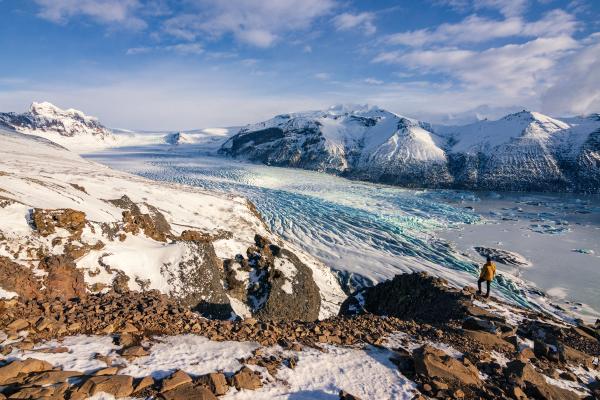
What to See in Vatnajökull National Park
As the park is so big, the list of things to see in Vatnajökull is almost endless. Don’t imagine that it is all ice, there are many different ecosystems within the park limits. We have narrowed it down to the most impressive ones.
Vatnajökull Glacier
The star of the show. Vatnajökull Glacier is a frozen giant, its icy expanse stretching further than the eye can see. If you look at a map of Iceland, the huge white thing in the bottom right corner, that’s Vatnajökull Glacier.
Spanning 8,100 square kilometers, it’s a labyrinth of crevasses, ridges, and hidden valleys, with many smaller glacier tongues going down the edges. There are several volcanoes under the surface, most of them dormant, but an occasional eruption can create a flood that would reshape part of Iceland.
It’s highly visible from everywhere in the park, as a constant looming presence. There are guided tours that take you hiking on the ice. The tours usually included crampons and other safety items, as well as fascinating insights about the glacier.
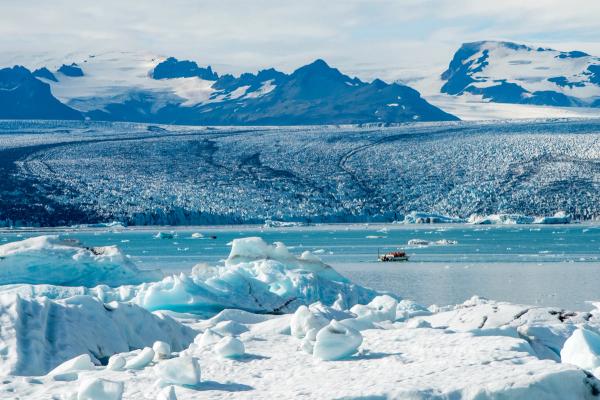
Jökulsárlón Glacier Lagoon
Few places rival Jökulsárlón Glacier Lagoon for sheer magic. It’s one of the most jaw-dropping natural monuments in Iceland. Here, we can find icebergs that have separated from the Breiðamerkurjökull glacier tongue and float in the water before drifting to the sea. These chunks of ice have different colors, and some of them are of an intense blue, creating a surprising sight.
There are boat tours—zodiac or amphibian— that go into the lagoon and allow you to see the icebergs from up close. It’s quite common to spot seals here as well. Many of the pieces of ice end up in the nearby Diamond Beach, where they shine under the sun, hence the name of the beach. The contrast between the different shades of the ice against the black sand is simply astonishing.

Ice Caves
The ice caves inside the Vatnajökull glacier are another fantastic experience to witness this side of Iceland. In spring and summer, meltwater makes its way through the glacier, creating caves and tunnels. Then, when the cold arrives again, the water freezes, and the caves are formed. This means that they are not the same from year to year. Each cave is unique, shaped by nature, and no two visits are the same. Some of them are huge, like stepping inside an ice cathedral.
Open from November to March, when temperatures stabilize, the ice is accessible only with guided tours due to safety risks. Your guide will share tales of the glacier’s history as you enjoy looking at the light filtering through the ice. It’s a popular activity in the colder months, so book a spot in advance.
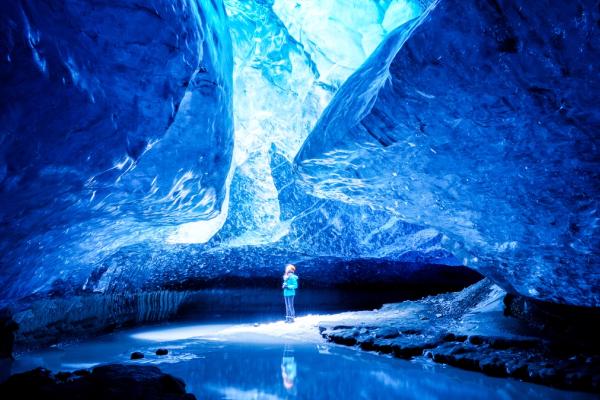
Skaftafell
Skaftafell is a green oasis in the middle of all the ice. It’s one of the most geologically diverse areas of the park. In the past, it was a national park in itself, but was later integrated into the larger Vatnajökull.
This nature reserve is very varied, and is best discovered by hiking on some of the many trails that can be found here. Some of them wind through birch forests and meadows, leading to sights like Svartifoss, one of the most iconic waterfalls in Iceland. The cascade is framed by hexagonal basalt columns that look like organ pipes.
One of the glacier tongues coming out of Vatnajökull, Skaftafellsjökull, goes inside Skaftafell, and it’s not far on foot from the parking area.
The visitor center offers maps and exhibits on the park’s geology, making it a great stop to plan your day.
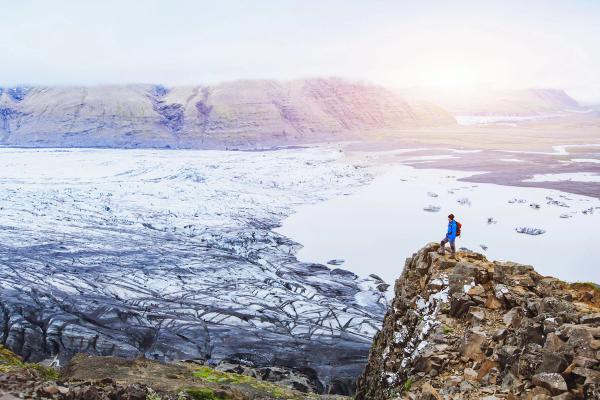
Dettifoss
The national park is so big that it reaches parts well up into North Iceland. There, we can find Dettifoss, Europe’s second most powerful waterfall. It’s part of the glacial Jökulsá á Fjöllum river, which originates in one the tongues of the Vatnajökull glacier.
The waterfall has a drop of 44 meters and is 100 meters wide, sending a cloud of mist into the air. The roar produced by the water can be heard from quite some distance.
There’s a parking area, and from there you can go to the viewing platforms on both sides of the waterfall, each one offering different perspectives.

Hvannadalshnúkur
Hvannadalshnúkur, Iceland’s highest peak at 2,110 meters, looms in the southern part of the park, between Skaftafell and Jökulsárlón Glacier Lagoon. It can be seen from many points along the south coast, and it’s possible to hike to the summit, but it’s not a casual walk. Think 10-12 hours of guided trekking across glaciers and rocky slopes, only recommended for experienced mountain hikers.
If you manage to accomplish this feat, the views from the top are unique. On one side, you’ll have the endless icy expanse of the Vatnajökull. On the other, the North Atlantic Ocean.
Based out of Skaftafell, this adventure is for fit hikers looking for a challenge. Even if you don’t climb, the peak’s silhouette against the sky is a sight to behold.

What to Do in Vatnajökull National Park and Nearby
Vatnajökull National Park will have you doing activities all day long. It's not a place to get bored.
Hiking
Vatnajökull is a hiker’s paradise, with trails for every level. In Skaftafell, short walks to Svartifoss or Skaftafellsjökull take just a couple of hours, perfect for a quick outing. Longer treks, like the 6-hour Kristínartindar loop, reward with sweeping views of glaciers and peaks. In the north, Jökulsárgljúfur’s paths explore cliffs and Dettifoss’ misty gorge. For the adventurous, multi-day routes in Lónsöræfi or the highlands around Askja offer solitude and rugged beauty.
Always carry a map, check weather forecasts, and stick to marked trails; Iceland’s terrain doesn’t mess around.
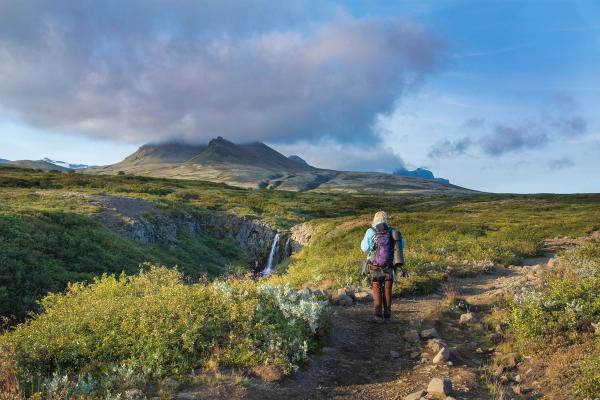
Wildlife
Many animal species have made Vatnajökull National Park their home, and they are relatively easy to see if you know where to look.
As we mentioned before, it’s pretty common to spot seals at Jökulsárlón Glacier Lagoon, swimming among the icebergs or resting on rocks. Arctic foxes, Iceland’s only native land mammal, can be seen in the Highlands, but they are elusive and quick. Also, their fur changes colors with the seasons, white in winter and greyish-brown in summer, camouflaging perfectly with its surroundings.
The park, and Iceland in general, is a great place for birdwatching. Puffins nest in the coastal cliffs in the summer months. Fulmars, razorbills, and kittiwakes also live near the sea. Inland, it’s not uncommon to see redwings and common snipes.
Bring binoculars if you want to see them, as getting too close can disturb them. Early morning or late evening are usually the best times to see animals.
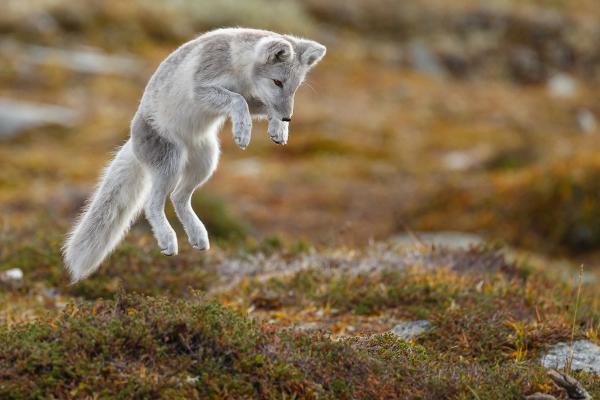
Glacier Tours
Nothing beats walking on a glacier, and Vatnajökull delivers. Guided tours are available year-round and range from easy strolls on Skaftafellsjökull to adrenaline-pumping ice climbs on Falljökull. Guides outfit you with crampons, helmets, and ice axes, sharing knowledge about glacial formations and the park’s volcanic underbelly.
Tours depart from Skaftafell or Jökulsárlón, lasting 3-5 hours, and cater to beginners and experts alike. It’s a chance to feel the glacier’s pulse beneath your feet, a memory that lingers long after you’re back in your camper.

Photography Options
If you’re into photography, especially natural elements, you’re going to love Vatnajökull National Park. The collection of different environments and ecosystems creates endless opportunities to snap amazing pictures.
The small icebergs at Jökulsárlón shine under the light, especially at sunrise. On the other side of the road, Diamond Beach is a place that deserves to be captured. We could go on and on, but we would need a completely new article.
If you have good equipment, bring a tripod and different lenses.

Where’s Vatnajökull National Park and How to Get There
That’s a tricky question to answer, because Vatnajökull National Park is so big that it depends on where you want to go inside the park. And there are many places to enter the park. However, most of the things people want to visit are in the southern part, where places like Skaftafell or Jökulsárlón Glacier Lagoon are. For this reason, we’re going to explain how to get to that area from the country’s capital, Reykjavik.
The best way to get there is by car or campervan, as public transport options are limited and it would take quite some time.
The itinerary is long, but it’s quite easy to follow. Start by taking the Ring Road (Route 1) eastbound. After 330 kilometers (205 miles), you’ll arrive at Skaftafell. It takes about 4.5 hours. Jökulsárlón is another 55 kilometers (34 miles), about 45 minutes further east. For the northern sights like Dettifoss, it’s a 600-kilometer (373-mile) route, roughly 7.5 hours.
The Ring Road is open all year, but there could be temporary disruptions due to the weather, mostly in winter. Also, some secondary roads can be closed in the colder months, so always check the road conditions before traveling.
Where to Stay in Vatnajökull National Park and Nearby
There are several options to spend the night with your campervan close to Vatnajökull National Park. Remember that wild camping is illegal in Iceland, so stick to designated camping areas. Here you have five great options.
Skaftafell Campground
Opening Period: Year-round.
This camping site is inside the national park, just meters away from the Skaftafell visitor center. It’s one of the best options if you want to stay close to nature.
It’s quite big, with lots of pitches for both tents and campervans, with more than 400 spots. The facilities are basic but well-maintained, with toilets, showers (additional fee), sinks to do the dishes, and tables for eating. There’s no kitchen, so you must cook in your van or on a stove you bring.
The location is unbeatable, and some of the best trails in the nature reserve, like the ones leading to Svartifoss and Skaftafellsjökull, start at the campsite.

Svínafell Campground
Opening Period: May to September.
Just a short drive from Skaftafell, Svínafell offers a quieter escape with a large service building, Skáli, housing toilets, showers, and a communal kitchen. Campervans are welcome, but there’s no electricity available.
This site also has six cabins for four people that can be rented, but you must bring your own sleeping bag. They don’t take reservations in advance.
Myllulækur Campground
Opening Period: June to September.
This recently opened camping site is located in the eastern part of the park, near Höfn, one of the most important cities along the south coast. It’s a basic camping ground, with toilets, showers (coin-operated), electricity, and Wi-Fi. Pets are welcome.
Höfn Camping Ground
Opening Period: Year-round.
In the coastal town of Höfn, near Jökulsárlón, this campground is a convenient base if you want easy access to services. The town’s center is quite close, and there you can find shops, restaurants, and a gas station, so it's perfect for restocking.
The campsite has toilets, showers, electricity, Wi-Fi, cooking facilities, and a playground for children.
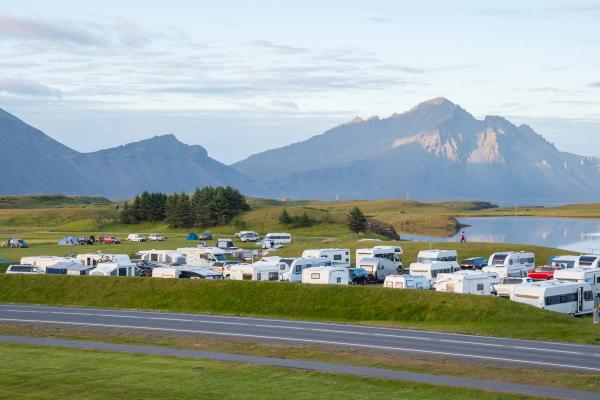
Nýidalur FI Mountain Hut Campsite
Opening Period: July and August.
This one is a bit remote, but the setting is astonishing. Located in the Highlands and accessible by F-roads, this place has several huts, but no camping area. It can accommodate quite a lot of people in bunk beds, and there are toilets and showers in a separate hut.
The Weather at Vatnajökull National Park
The weather in Iceland is quite unpredictable and changes constantly. Each season is different, but you can expect a mix of everything, regardless of the season you’re visiting.
Spring (April and May)
Spring is still a bit cold in Vatnajökull, with an average temperature of 0-5°C (32-41°F). Also, rain and snow showers keep things unpredictable. Days grow longer each week, giving you more time to explore, though some trails and roads can be difficult, even impossible, to navigate.
Summer (June to August)
Summer’s the sweet spot, with 8-15°C (46-59°F) and near-24-hour daylight by the last week of June. It’s the best moment for hiking and camping, but rain can hit at any time, so wear waterproof clothes. It’s a good moment for glacier hiking, but you can’t visit the ice caves. Some camping sites can get busy, so book in advance if possible.
Autumn (September and October)
Autumn cools to 3-10°C (37-50°F), with shorter days and occasional snow in higher areas, especially in October. Campsites start closing, but the Northern Lights start to be visible in this season.
Winter (November to March)
This season can be hard in certain parts of the Vatnajökull National Park. The temperature is often below the freezing point, with frequent snow or wind. This is the season for visiting the ice caves, but many roads and campsites close. If you’re coming in this season, you’ll need a 4x4 campervan.
Travel Tips
- Reserve Campsites Early: In summer, camping sites like Skaftafell and Höfn fill fast. Not all the camping grounds in Iceland take reservations, but do, when possible, especially if you need electricity for your campervan. It will avoid last-minute problems.
- Layer Up: Iceland’s weather can change really quickly. The best way to adapt to these changes is to wear layers. Pack a waterproof jacket, fleece, thermal base layers, and a sleeping bag rated for 5-10°C (41-50°F) to stay cozy in your camper.
- Stick to Campsites: Wild camping is forbidden in Iceland, including Vatnajökull. Use designated sites to avoid fines and help preserve the fragile ecosystems of the park.
- Monitor Roads and Weather: Check the IRCA and the Icelandic Met Office daily for road conditions and forecasts, especially on F-roads or in winter. A GPS or offline map app can be a lifesaver.
- Get a Camping Card: The Iceland Camping Card (around 19,000 ISK, (154$) ) gives discounts at over 40 sites, including Skaftafell, stretching your budget for more adventures. Not all camping sites accept it, though.
- Stock Up Wisely: Fuel and groceries are scarce in remote areas. Fill up in Höfn, Egilsstaðir, or Vík. Pack extra food and water for highland trips.
- Book Guided Tours: Glacier hikes and ice cave tours require going with an expert guide for safety. Book them in advance.
- Cooking Gear: Not all camping sites have cooking facilities, so rent or buy a gas stove and other elements like pans and cutlery to be self-sufficient.
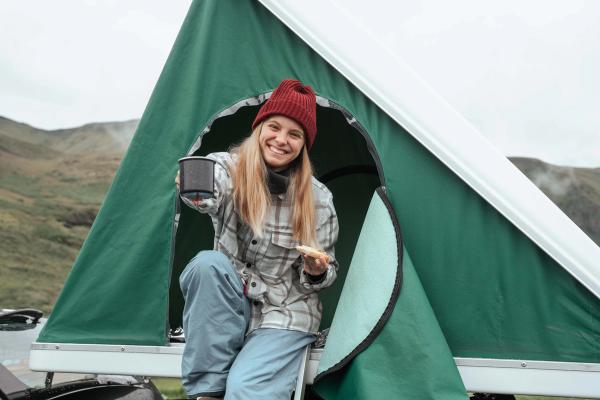
Conclusion
In not many places does nature display its pure, raw power as it does in Vatnajökull National Park. It’s Iceland at its wildest, with glaciers, waterfalls, forests, lagoons, and much more. With your campervan, you’ll be able to discover this vast area and find great places to sleep. Don’t hesitate and get ready for a fantastic experience in the place that puts the ice in Iceland.



